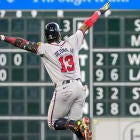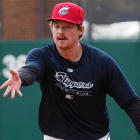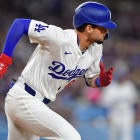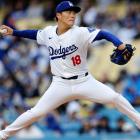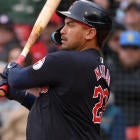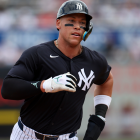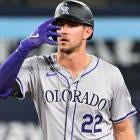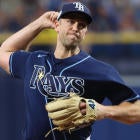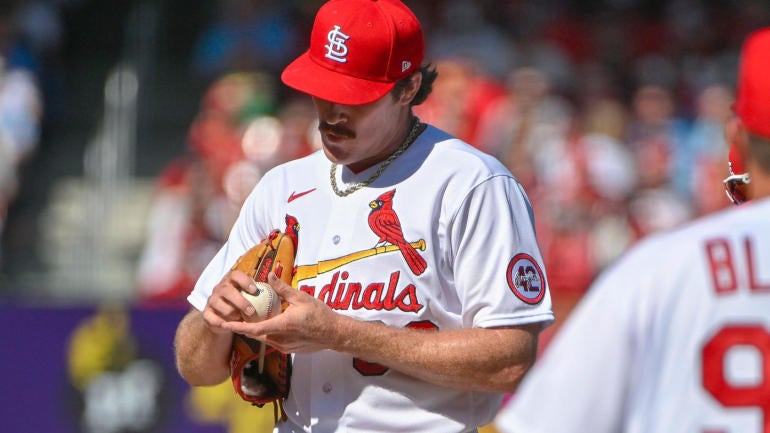
Normally this time of year, I'm writing articles intended to talk people off the ledge, reminding them that what we've seen so far is but a blip in a very long season for a sport that's particularly volatile from day to day.
Here's one you may have heard before: those same crooked pitching lines that are so front and center now will be on the periphery when they're happening to someone else in June. And another: just look at last April's stats with the benefit of 20/20 hindsight and consider how little they actually mattered. Blah blah and yadda yadda.
It's good advice that's withstood the test of time, and maybe I'll get around to writing that article at some point this month. But right now, only five days into my 24th year playing Fantasy Baseball, what stands out most is how anxious I am about everything, unable to muster the cool confidence I'm known for (fact check: coolness has never been something I'm known for).
Maybe it's because MLB has thrown so many world-shattering changes at us the past few years that I've lost all sense of normality -- particularly with this year's changes, which might be the biggest yet. Or maybe it's just the creeping realization that time is finite and we're all going to die sooner than we're ready.
Whatever the case, I've come up with three concerns that I think, even at this early stage of the season, are valid. Just don't expect to find mention of Corbin Burnes' poor outing or Manny Machado's slow start. Those concerns fall into that other, less valid category.
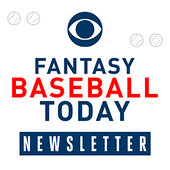
Fantasy Baseball Today Newsletter
Your Cheat Code To Fantasy Baseball
You're destined to gain an edge over your friends with advice from the award-winning FBT crew.
Thanks for signing up!
Keep an eye on your inbox.
Sorry!
There was an error processing your subscription.
Increased vulnerability on balls in play
You may have heard that stolen bases are up -- like, way up. Entering play Monday, there were 70 across all of baseball. That's compared to 29 through four days of play last year. It's a big change, but with the new pickoff limits put on pitchers, I anticipated as much. I saw the minor-league data after the same rule changes were applied there, and I thought, if anything, people were underselling the impact it would have on the major-league game.
It's the other big rule change that's throwing me, the shift ban -- which, more specifically, requires teams to have two fielders on each side of second base. I thought a smattering of hitters would benefit, mostly those batting from the left side, but that the increase would be hardly noticeable on the pitching end because, well, it would only be a smattering of hitters.
But it looks like more than a smattering. League-wide BABIP entering play Monday was .301. That's compared to .276 through four days of play last year, a staggering increase. Even compared to the .290 BABIP for all of 2022, we're simply in a different reality now. And BABIP is generally at its lowest in April, when temperatures are down and the ball doesn't carry as well. What sort of BABIP will be looking at in July?
The effect of all those batted balls sneaking past fielders is this:
- 10 hits in 3 1/3 innings for Miles Mikolas
- nine hits in 3 1/3 innings for Alek Manoah
- nine hits in 4 1/3 innings for George Kirby
- nine hits in 5 1/3 innings for Charlie Morton
- eight hits in six innings for Kevin Gausman
- eight hits in five innings for Cristian Javier
- seven hits in 4 1/3 innings for Zack Wheeler
- seven hits in five innings for Nestor Cortes
That's a lot of hits surrendered by some really good pitchers, and I'll note that it's far from a complete list.
Certainly, not all of these pitchers' starts will go that way. The usual caveats about a one-game sample apply. But that it's happened to so many in a year when league-wide BABIP shows a sharp increase I think is a concerning sign.
What's the concern exactly? I'm still parsing through that. Increased volatility from start to start, maybe, because there's a higher element of "luck" on batted balls now. We may also have to adjust our expectations for what makes a good WHIP, though if the inflation is applied equally across the board, that's not such a big deal. My biggest concern is that it won't be applied equally across the board, that the biggest bat-missers and/or those who generally put the ball in the air will have a big WHIP advantage over the modest bat-missers and/or those who generally put the ball in the ground.
It's too early to say for sure, but just when it seemed like parity had returned to the pitching ranks after the madness of the juiced ball era, a new chasm may be opening up.
Pitchers that may be wasted picks
This one goes hand-in-hand with the first concern. No, I'm not so worried Manoah, Javier, Wheeler or Cortes. They're all established bat-missers and/or fly-ball pitchers. It's the Mikolas class of pitcher, those who previously found success pitching to contact, that could be in for a long year.
I'm not suggesting you dump him based solely on a theory. He found success this spring, when the shift ban was also in effect, so there are likely other reasons why his first start went so poorly. But he only had one start as bad as that last year. It stands to reason he's in danger of more now.
Others who would fit that description include Martin Perez (eight hits in 5 2/3 innings) and Cal Quantrill (eight hits in 4 2/3 innings). Then again, so would Drew Rasmussen, who just two-hit the Nationals over six shutout innings in what was one of the best starts of the season so far, which goes to show you that it's still possible for such a pitcher to find success. It's just that there's less margin for error now.
This concern of having wasted picks on certain pitchers goes beyond just the rule changes and how they might impact a certain type. Completely independent of league batting trends, a few have showed such grave concerns the first time through the rotation that they're already on thin ice for me. I'm talking mainly about Chris Bassitt, Jose Berrios and Jack Flaherty.
To be fair, the latter two were already on thin ice after the way their 2022 went, but their track record and much of the underlying data offered reason for optimism. Still, they were terrible in spring training and clearly didn't flip the switch with the start of the regular season. The fact Flaherty allowed no hits is of little consolation given that he walked seven and his velocity was down more than 2 mph. If he and Berrios don't show clear signs of improvement next time out, I'm ready to move on.
Bassitt gets a longer leash because he was actually, you know, good last year, but he struggled with reduced velocity all spring, which showed up in the numbers. His fastball being down 1.7 mph in his season debut would seem to continue the trend. He's another of that Mikolas class of starting pitcher who previous found success pitching to contact, so even at full velocity, there would be reason for skepticism.
Quality hitters with platoon concerns
Three of my favorite outfielders coming into the season were Oscar Colas, Garrett Mitchell and Jake Fraley. I liked the upside at the cost, particularly at a position so lacking. But here's the problem: none of them has started against a left-handed pitcher yet.
They're not the only ones, of course. Triston Casas, Brice Turang, James Outman, Darick Hall and Kerry Carpenter are other young upside bats who are mired in platoon roles to begin the year simply by virtue of batting left-handed. Though we haven't seen it yet, Nolan Gorman and Blake Sabol probably fall into that category as well.
It's not just a matter of lefty/righty either. The way the Braves have deployed their catching tandem has thrown everyone for a loop. Travis d'Arnaud has started all four games -- two at DH, two at catcher -- while Sean Murphy, their big offseason acquisition who they immediately signed to a long-term deal, has started only two. Murphy still figures to get the majority of the starts behind the plate -- his big arm will come in handy with the increase in stolen bases -- but it does seem like d'Arnaud is the more likely of the two to slide into DH on his off days. Even if he's playing just 60-65 percent of the time, Murphy would still matter in two-catcher leagues, but what about shallower one-catcher leagues?
That's really the issue for all of these players. If they perform like we expect them to, they probably break free from the platoon and become full-timers of major consequence in Fantasy. For Fraley in particular, it's hard to see him sitting so regularly if he's one of the Reds' best 2-3 hitters. There's also a tendency among managers to spread the love early on, giving everyone a chance to get their feet wet before settling in for the long haul.
But ... in shallower leagues especially, with the waiver wire abounding in exciting new alternatives, how long do we wait them out? Is the long-term payoff worth a short-term hit if we're forced to start them? How certain are we of the long-term payoff anyway?
I don't know these answers, but for the players I believe in, I'm going to hold out as long as I can.



















